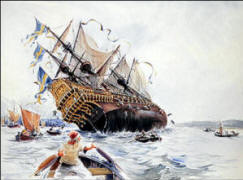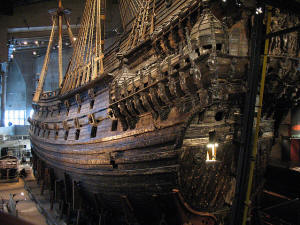|
Unique Cruise Solutions The news you need to know |
|||||||||||||||||
|
|||||||||||||||||
 |
 |
|
|||||||||||||||
|
Cruise News for the Corporate Travel Professional |
May 2011 Edition |
||||||||||||||||
|
How one of Sweden's biggest failures became a national treasure |
||||||||||||||||
|
Half a century has passed since the sunken 17th century royal
warship Vasa was brought to the surface, but the story of how one of Sweden's
biggest failures became a national treasure still fascinates. "The first thing we saw was a little wooden head, and after some time came another wooden head... It was a fantastic sight," said retired navy commander Jarl Ellsen, ahead of Sunday's 50th anniversary of the raising of the ship. Slowly, what was once briefly the crown jewel of the Swedish navy was raised off the Baltic sea bed where it had rested for more than 300 years after pitifully sinking just minutes into its maiden voyage. For the large crowd gathered at the Stockholm harbour on April 24, 1961 and the some 100 million people following the event from around the world on television and radio, the suspense was enormous. "We didn't know how she would behave," said 90-year-old Ellsen, who at the time was a spokesman for the Swedish navy. "It was very exciting. She came up rather slowly because they had to take it very, very easy not to break her," he said.  More
than three centuries earlier, the Vasa, commissioned by Swedish King Gustav II
Adolf to be the mightiest warship in the world, set sail in the late afternoon
of August 10, 1628 on its maiden voyage. More
than three centuries earlier, the Vasa, commissioned by Swedish King Gustav II
Adolf to be the mightiest warship in the world, set sail in the late afternoon
of August 10, 1628 on its maiden voyage.After raising its massive sails and firing celebratory canon shots in front of the royal palace in Stockholm, the ship majestically glided off, only to discover after a few minutes and a mere kilometre out, it did not have enough ballast to counteract the weight of its 64 guns. "The Vasa story is the story of a historic fiasco," said Marika Hedin, a historian and head of the Vasa Museum, today by far Sweden's most visited museum. Managing to raise the 69-metre (226-foot) wreck nearly intact -- the first ever underwater salvage of such a large vessel -- "gave the ship back its symbolic meaning for Sweden as a success story," she said. "It was an absolutely crazy project," Hedin admits, pointing out that at the time the salvage began, no one had any idea if it would even be possible, how much it would cost or if the ship would remain intact. Yet the enthusiasm around the project was enormous: "I think the idea was to salvage her and also to rewrite the history around her, to make her an example and the symbol of those greater days" in Sweden's glory period during the rein of Gustaf II Adolf, she said. Swedish military circles were eager to revamp the Scandinavian country's image felt by many to have been tainted by what they saw as its "cowardice" in remaining neutral throughout World War II, Hedin added. Vasa's second life began in 1956 when navy engineer Anders Franzen located the wreck at a depth of 32 meters (105 feet). He had been looking for the all-but-forgotten warship, knowing that the Baltic Sea was perfect for preserving wrecks due to the fact that the teredo, a wood-penetrating ship worm, is absent from its icy, brackish waters. In fact, today some 20,000 ship wrecks have already been discovered at the bottom of the Baltic, while archeologists suspect there could be more than 100,000. Far fewer were known of when Franzen began his tireless search, using a special core sampler which, after years of patience, one day pulled up a piece of blackened oak from a depth of about 30 metres. Diver Per Edvin Faelting plunged in and quickly contacted Franzen by radio: "I can't see anything, since it's pitch-dark here, but I can feel something big -- the side of a ship," he said. "Here is one gun port and here's another. There are two rows. It must be the Vasa." Soon ideas -- many of them far-fetched -- of how to bring the majestic rig to the surface were being tossed around: should they freeze the ship and the water around it before raising it and letting the iceberg melt in the sun, or perhaps fill it with ping-pong balls that would help float it to the surface? In the end, it was decided to slip massive steel cables under the hull and lift the wreck out of the water. But digging out the seabed beneath the hull to make room for the cables was no small feat, with the divers constantly fearful the massive ship would collapse on top of them. "We were military divers and we were given an order to dive," said Aake Lindquist, acknowledging that at the time he was just 19 and "didn't know how exciting it was."  "At
the time it was just a black ghost lying 32 metres under the surface," he said. "At
the time it was just a black ghost lying 32 metres under the surface," he said.
Housed in a special museum built over an old dry dock, the Vasa is today the world's most visited maritime museum and expects to register at the end of this month its 30 millionth visitor in 20 years. (By: Francois Campredon) |
 |
||||||||||||||||
|
|
|||||||||||||||||
|
|
|||||||||||||||||
| Up | |||||||||||||||||
| Up | |||||||||||||||||
|
Worldwide Travel & Cruise Assoc., Inc. 150 S. University Dr. Ste E, Plantation, FL 33324 - USA Tel: +1 954 452 8800 Fax: +1 954 252 3945 EMail: sales@cruiseco.com |
|||||||||||||||||
|
Designed & Published by: Worldwide Media. |
|||||||||||||||||

